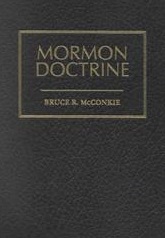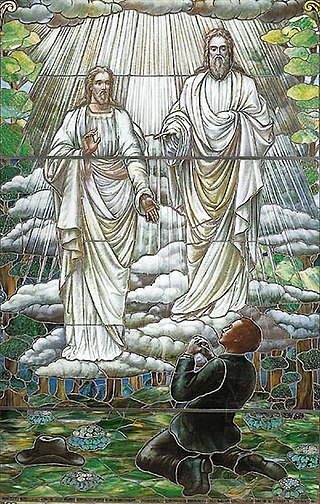The Book of Jarom is the fifth book in the Book of Mormon. According to the text it was written by Jarom, who was the son of Enos and a descendant of Jacob, the brother of the prophet Nephi.
The First Book of Nephi: His Reign and Ministry, usually referred to as First Nephi or 1 Nephi, is the first book of the Book of Mormon, the sacred text of churches within the Latter Day Saint Movement, and one of four books with the name Nephi. First Nephi tells the story of his family's escape from Jerusalem prior to the exile to Babylon, struggle to survive in the wilderness, and building a ship and sailing to the "promised land", commonly interpreted by Mormons as the Americas. The book is composed of two intermingled genres; one a historical narrative describing the events and conversations that occurred and the other a recounting of visions, sermons, poetry, and doctrinal discourses as shared by either Nephi or Lehi to members of the family.
The Second Book of Nephi, usually referred to as Second Nephi or 2 Nephi, is the second book of the Book of Mormon, the primary religious text of the Latter-day Saint Movement. Narrated by Nephi, son of Lehi, unlike the first Book of Nephi, 2 Nephi contains little history of the Nephite people and focuses predominately on visions and prophecies of Nephi himself and other prophets, particularly Isaiah.
Stephen Edward Robinson was a religious scholar and apologist, who was a member of the Church of Jesus Christ of Latter-day Saints.

Babylon the Great, commonly known as the Whore of Babylon, refers to both a symbolic female figure and a place of evil as mentioned in the Book of Revelation of the New Testament. Her full title is stated in Revelation 17:5 as "Mystery, Babylon the Great, the Mother of Harlots and Abominations of the Earth".

The Church of Christ was the original name of the Latter Day Saint church founded by Joseph Smith. Organized informally in 1829 in upstate New York and then formally on April 6, 1830, it was the first organization to implement the principles found in Smith's newly published Book of Mormon, and thus its establishment represents the formal beginning of the Latter Day Saint movement. Later names for this organization included the Church of the Latter Day Saints, the Church of Jesus Christ, the Church of God, the Church of Christ of Latter Day Saints, and the Church of Jesus Christ of Latter Day Saints.

In orthodox Mormonism, the term God generally refers to the biblical God the Father, whom Latter Day Saints also refer to as Elohim or Heavenly Father, while the term Godhead refers to a council of three distinct divine persons consisting of God the Father, Jesus Christ, and the Holy Ghost. However, in Latter Day Saint theology the term God may also refer to, in some contexts, the Godhead as a whole or to each member individually.

Bruce Redd McConkie was a member of the Quorum of the Twelve Apostles of the Church of Jesus Christ of Latter-day Saints from 1972 until his death. McConkie was a member of the First Council of the Seventy of the LDS Church from 1946 until his calling to the Quorum of the Twelve Apostles.
The law of consecration is a commandment in the Latter Day Saint movement in which adherents promise to dedicate their lives and material substance to the church. It was first referred to in 1831 by Joseph Smith.

A secret combination, in the accounts of the Book of Mormon, is a term that describes a malignant secret society of "people bound together by oaths to carry out the evil purposes of the group." Secret combinations were first discussed in the Book of Mormon, which was published in 1830 by Joseph Smith. The most notable example of a secret combination is the Gadianton robbers, a conspiracy throughout much of the narrative of the Book of Mormon. According to the Joseph Smith Translation of the Bible, Cain also entered a secret combination with Satan and became Master Mahan.
Joseph Fielding McConkie was a professor of Ancient Scripture at Brigham Young University (BYU) and an author or co-author of over 25 books.
The Church of Jesus Christ of Latter-day Saints teaches that Adam and Eve were the first man and the first woman to live on the earth and that their fall was an essential step in the plan of salvation. Adam in particular is a central figure in Mormon cosmology.

Community of Christ and the Church of Jesus Christ of Latter-day Saints are two denominations that share a common heritage in the Church of Christ founded by Joseph Smith on April 6, 1830. Since Smith's death in 1844, they have evolved separately in belief and practices. The Church of Jesus Christ of Latter Day Saints is headquartered in Salt Lake City, Utah, and claims more than 17 million members worldwide; Community of Christ is headquartered in Independence, Missouri, and reports a worldwide membership of approximately 250,000.

Mormon Doctrine is an encyclopedic work written in 1958 by Bruce R. McConkie, a general authority of the Church of Jesus Christ of Latter-day Saints. It was intended primarily for a Latter-day Saint audience and has been used as a reference book by church members because of its comprehensive nature, and was a highly influential all-time bestseller in the LDS community. It was viewed by many members both then and now as representing official doctrine despite never being endorsed by the church. It has been both heavily criticized by some church leaders and members and well regarded by others. After the book's first edition was removed from publication at the instruction of the church's First Presidency and Quorum of the Twelve, corrections were made in subsequent editions. The book went through three editions but has been out of print since 2010.
Members of the Church of Jesus Christ of Latter-day Saints and other adherents in the Latter Day Saint movement, believe that there will be a Second Coming of Jesus Christ to the earth sometime in the future. The Church and its leaders do not make predictions of the actual date of the Second Coming.
The Church of Jesus Christ of Latter-day Saints takes no official position on whether or not biological evolution has occurred, nor on the validity of the modern evolutionary synthesis as a scientific theory. In the twentieth century, the First Presidency of the LDS Church published doctrinal statements on the origin of man and creation. In addition, individual leaders of the church have expressed a variety of personal opinions on evolution, many of which have affected the beliefs and perceptions of Latter-day Saints.

The Church of Jesus Christ of Latter-day Saints focuses its doctrine and teaching on Jesus Christ; that he was the Son of God, born of Mary, lived a perfect life, performed miracles, bled from every pore in the Garden of Gethsemane, died on the cross, rose on the third day, appeared again to his disciples, and now resides, authoritatively, on the right hand side of God. In brief, some beliefs are in common with Catholics, Orthodox and Protestant traditions. However, teachings of the LDS Church differ significantly in other ways and encompass a broad set of doctrines, so that the above-mentioned denominations usually place the LDS Church outside the bounds of orthodox Christian teaching as summarized in the Nicene Creed.

The tree of life vision is, according to the Book of Mormon, a vision received in a dream by the prophet Lehi, and later in vision by his son Nephi, who wrote about it in the First Book of Nephi. The vision includes a path leading to a tree symbolizing salvation, with an iron rod along the path whereby followers of Jesus may hold to the rod and avoid wandering off the path into pits or waters, symbolizing the ways of sin. The vision also includes a large building where the wicked look down on the righteous and mock them.

The standard works of Mormonism—the largest denomination of which is the Church of Jesus Christ of Latter-day Saints —have been the subject of various criticisms. Latter-day Saints believe the Book of Mormon is a sacred text with the same divine authority as the Bible; both are considered complementary to each other. Other Mormon sacred texts include the Pearl of Great Price and Doctrine and Covenants, which are also recognized as scripture. Religious and scholarly critics outside Mormonism have disputed Mormonism's unique scriptures, questioning the traditional narrative of how these books came to light and the extent to which they describe actual events. Critics cite research in history, archeology, and other disciplines to support their contentions.









